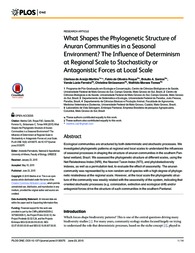What shapes the phylogenetic structure of anuran communities in a seasonal environment? The influence of determinism at regional scale to stochasticity or antagonistic forces at local scale.
What shapes the phylogenetic structure of anuran communities in a seasonal environment? The influence of determinism at regional scale to stochasticity or antagonistic forces at local scale.
Autoria: MARTINS, C. de A.; ROQUE, F. de O.; SANTOS, B. A.; FERREIRA, V. L.; STRUSSMANN, C.; TOMAS, W. M.
Resumo: Ecological communities are structured by both deterministic and stochastic processes. We investigated phylogenetic patterns at regional and local scales to understand the influences of seasonal processes in shaping the structure of anuran communities in the southern Pantanal wetland, Brazil. We assessed the phylogenetic structure at different scales, using the Net Relatedness Index (NRI), the Nearest Taxon Index (NTI), and hylobetadiversity indexes, as well as a permutation test, to evaluate the effect of seasonality. The anuran community was represented by a non-random set of species with a high degree of phylogenetic relatedness at the regional scale. However, at the local scale the phylogenetic structure of the community was weakly related with the seasonality of the system, indicating that oriented stochastic processes (e.g. colonization, extinction and ecological drift) and/or antagonist forces drive the structure of such communities in the southern Pantanal.
Ano de publicação: 2015
Tipo de publicação: Artigo de periódico
Unidade: Embrapa Pantanal
Palavras-chave: Biodiversidade, Biogeography, Biological diversity, Community ecology, Seasonality, Southern Pantanal
Observações
1 - Por padrão são exibidas publicações dos últimos 20 anos. Para encontrar publicações mais antigas, configure o filtro ano de publicação, colocando o ano a partir do qual você deseja encontrar publicações. O filtro está na coluna da esquerda na busca acima.
2 - Para ler algumas publicações da Embrapa (apenas as que estão em formato ePub), é necessário ter, no celular ou computador, um desses softwares gratuitos. Sistemas Android: Google Play Livros; IOS: iBooks; Windows e Linux: software Calibre.
Acesse outras publicações
Acesse a Base de Dados da Pesquisa Agropecuária (BDPA) para consultar o acervo completo das bibliotecas da Embrapa.

